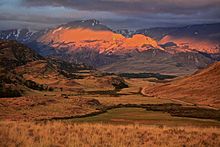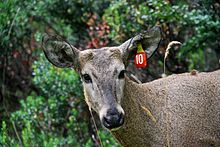- Conservacion Patagonica
-
Conservacion Patagonica Mission To protect and restore Patagonia's wildland ecosystems, biodiversity, and healthy communities through creating national parks Founded 2000 President Kristine Tompkins Website http://www.conservacionpatagonica.org Conservacion Patagonica is a conservation group whose mission is "protecting and restoring wildland ecosystems, biodiversity, and healthy communities in Patagonia through the formation of new national parks."[1] Founded in 2000 by Kristine Tompkins, former CEO of Patagonia, Inc, Conservacion Patagonica first focused on the creation of Monte León National Park in Argentina, the country's first coastal national park.[2] The group played the central role in securing the funds for the purchase of Estancia Monte Leon and in creating long-term management plans for the new national park.
Creating Patagonia National Park
In 2004, Conservacion Patagonica (CP) launched its second project, the creation of Patagonia National Park in Chile's Aysen Region.[3] The group purchased Estancia Valle Chacabuco, a 178,000 sheep ranch in the Chacabuco Valley, which lies between two existing Chilean National Reserve, Jeinimeni and Tamango.[4] The conservation plan calls for the donation of CP's privately acquired land to the Chilean parks administration, which, in combination with Jeinimeni and Tamango National Reserves, will form one new national park of 650,000 acres.[5] As of 2011, the park is well over halfway complete.
The major program areas of the Patagonia National Park project include:
Strategic Land Acquisition: The bulk of land acquisition came with Conservacion Patagonica's 2004 purchase of the 173,000-acre Estancia Valle Chacabuco. Conservacion Patagonica has bought several other properties in the subsequent years, all from willing sellers to whom jobs were offered in the future park. One key inholding remains to be purchased.
Ecosystem Restoration: Patagonia has suffered its share of ecological abuse: intensive sheep ranching on sandy, arid soils has resulted in widespread desertification. In the transition from sheep ranch to national park, Conservacion Patagonica aims reverse these damages, restore productive habitat, and create a model of ecosystem restoration for Patagonia. The grasslands recovery program, launched in 2004, began with removing almost all livestock. Conservacion Patagonica’s volunteer program performs the bulk of the work of ecosystem restoration. As of 2011, they have removed over half of the 400 miles of habitat-fragmenting ranch fencing. Volunteers also collect seeds from native coiron grasses, which professional ecosystem restoration workers use to reseed heavily damaged areas.
Wildlife Recovery:
Conservacion Patagonica’s large-scale ecosystem restoration work serves as the foundation for targeted species-specific programs, such as the effort to monitor and protect the endangered and emblematic huemul deer. As wildness returns to this vast area, the populations of keystone species are finding a new equilibrium. With livestock gone, grasslands are producing more and better quality food for a range of herbivores, which have access to prime habitat and can roam freely without fences. Wildlife recovery programs take this ecosystem-level transition as the jumping-off point for initiatives to protect keystone species. The huemul deer represents the top priority for the Patagonia National Park project: habitat loss, disease transmitted from livestock, hunting, and predation by domestic dogs have diminished its population to 1,500 individuals left on Earth. Tracking pumas with GPS collars uncovers new information about their predation patterns, home ranges, and movements—critical data given their proximity to the huemul deer population. Simultaneously, Conservacion Patagonica is developing strategies, such as livestock guardian dogs, to mitigate predator-livestock conflicts.
Trails and Campgrounds: Through providing recreational opportunities, the park will bolster eco-tourism in the region, supporting local businesses and communities while inspiring a deeper respect for nature in park visitors. The network of trails and campgrounds under construction will provide access to different areas and ecosystems within the future park and will connect to existing trails in the adjacent National Reserves. Trails and hiking circuits maximize visitor engagement with the landscape while minimizing ecological impacts. In 2010, construction began of three trail systems and two campgrounds. The goal is to prepare the park for a pre-opening to the general public in late 2011.
Main Park Headquarters: The park headquarters—the central area where visitors come to eat, sleep, gather, and learn, where employees live and train, and where the surrounding community gathers—represent the heart of the future Patagonia National Park. Architecture serves as a tool for social change: the aesthetic quality of park infrastructure conveys the cultural value of nature. Historic Patagonian buildings provide with a vernacular architectural vocabulary tied to the region’s history. These durable, solid, well-insulated buildings will require minimal upkeep and uses local materials whenever possible: stone quarried on site and recycled wood. In addition, an innovative renewable energy system, composed of solar, wind, and mini-hydro generation facilities, will make the park the world’s first energy-independent park and minimize its carbon footprint. Community Engagement: The park will play a key role in the region’s economic transition from sheep ranching, a failure economically and ecologically, towards conservation and ecotourism. Through engaging children and other members of the local community, the park will inspire awareness and dedication to conservation. Conservacion Patagonica has offered jobs to all former gauchos and developed programs to retrain them as park rangers and conservation workers. A school outreach program brings local children into the park to learn about endangered species such as the huemul deer, and the potential community benefits of conservation. Conservacion Patagonica host the annual Huemul Festival and hike, in which our neighbors hike through the Tamango Reserve into Valle Chacabuco. Huemul scholarships have allowed more than fifty students to continue their studies.
Conservacion Patagonica in the Media
The 2010 film 180 Degrees South profiled Conservacion Patagonica and its work to protect and restore land in Patagonia.
See also
Kristine Tompkins
- ^ www.conservacionpatagonica.org
- ^ http://www.argentour.com/en/national_park/monte_leon.php
- ^ http://www.ft.com/cms/s/2/074d9748-bc51-11df-8c02-00144feab49a.html
- ^ http://www.actionatlas.org/conservation/landscapes/future-patagonia-national-park/summary/paa99A8F73EB1DB77D6D
- ^ http://www.patagonia.com/us/patagonia.go?assetid=1958
Wikimedia Foundation. 2010.



